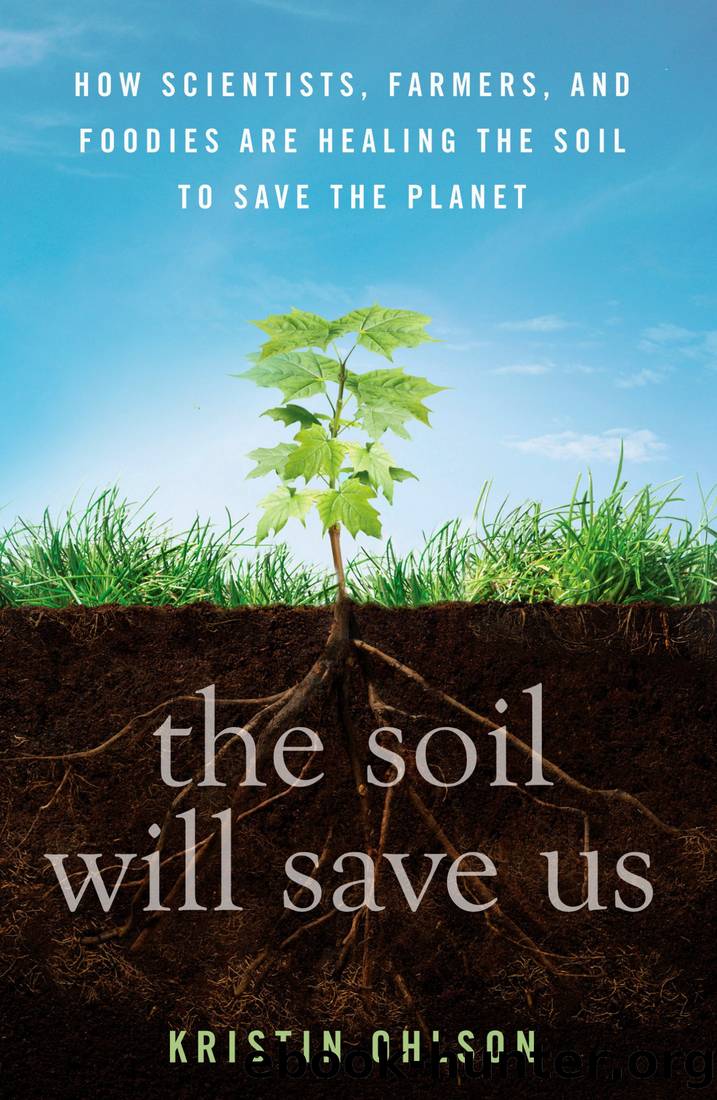The Soil Will Save Us by Kristin Ohlson

Author:Kristin Ohlson [Ohlson, Kristin]
Language: eng
Format: epub
ISBN: 9781609615550
Publisher: Potter/Ten Speed/Harmony/Rodale
Published: 2014-10-15T04:00:00+00:00
* * *
* A newly elected and more conservative government threatens to repeal the tax, perhaps by July of 2014.
CHAPTER 6
WHY DON’T WE KNOW THIS STUFF?
When I took a seat on my first day at the 2010 Quivira Coalition conference, my first thought was that I had never been in a room with so many cowboy hats. Soon I was dazzled by more than headgear.
In the morning, Doug Weatherbee from Dryland Solutions—he’s an Elaine Ingham protégé, trained at her Soil FoodWeb center in Oregon—paced the front of the room to discuss his work helping poor farmers in Mexico improve their yields without expensive inputs like fertilizer, pesticides, and other chemical tools. He built a contour ditch system at a test site to catch rainwater, then doused the soil and seedlings with compost tea, one of Ingham’s favorite ways of ushering microbial life into depleted soil. (First, you have to make good compost, which I later learned in a class with Ingham is a scientifically precise task—she is quite dismissive of the reduced waste or “putrescent slime” that often passes for compost.)
Weatherbee’s before and after photos were stunning. A year after he began his work, Mexico suffered the worst drought in 60 years. Fields dried up all around the test site, which stood out like a green flag against a yellow backdrop. At Weatherbee’s site, the cornstalks often had three branches bearing ears, versus unbranched, single stalks with solitary ears in the neighbor’s field. He suffered no corn borer worms, but they ravaged other fields. His ears of corn were voluptuous things with wild headdresses of red silk. The neighboring farmer—a very good farmer, Weatherbee said—had ears that looked like tiny dry pinecones.
In the afternoon, a lanky Missouri rancher named Greg Judy loped to the front of the room. He declared himself a microbe farmer and called his cattle mobile microbe tanks. He’d been “mob grazing” since 2007, which is a Savory-inspired approach that moves very large herds of cattle over relatively small plots of land—for Judy, that meant about 100,000 pounds of beef per acre. After one year, he had more forage (edible plants for the cattle), more earthworms, and better drought protection—his fields were still lush when his neighbors’ went dormant during a drought. He was so successful that he was able to quit his non-farm job. He expanded his operations by leasing nearby plots of land that were so depleted that no one bothered to farm them anymore. He marched his cattle up and down country roads to reach these other plots. They became so lush and filled with wildlife under his management that one hunting-enthusiast neighbor tore up the lease and invited him to mob his cattle through—he hits each property about twice a year—in perpetuity.
Some of my favorite lines from Judy’s entertaining spiel:
“Nature did it right for millions of years until we came and boogered things up.”
“I don’t put hay out for my cattle anymore. You put a bale of hay out for a cow and you turn her into a welfare recipient.
Download
This site does not store any files on its server. We only index and link to content provided by other sites. Please contact the content providers to delete copyright contents if any and email us, we'll remove relevant links or contents immediately.
Man-made Catastrophes and Risk Information Concealment by Dmitry Chernov & Didier Sornette(4736)
The Revenge of Geography: What the Map Tells Us About Coming Conflicts and the Battle Against Fate by Kaplan Robert D(3597)
Zero Waste Home by Bea Johnson(3291)
COSMOS by Carl Sagan(2950)
In a Sunburned Country by Bill Bryson(2948)
Good by S. Walden(2915)
The Fate of Rome: Climate, Disease, and the End of an Empire (The Princeton History of the Ancient World) by Kyle Harper(2436)
Camino Island by John Grisham(2383)
A Wilder Time by William E. Glassley(2363)
Organic Mushroom Farming and Mycoremediation by Tradd Cotter(2307)
Human Dynamics Research in Smart and Connected Communities by Shih-Lung Shaw & Daniel Sui(2178)
The Ogre by Doug Scott(2114)
Energy Myths and Realities by Vaclav Smil(2060)
The Traveler's Gift by Andy Andrews(2011)
Inside the Middle East by Avi Melamed(1940)
Birds of New Guinea by Pratt Thane K.; Beehler Bruce M.; Anderton John C(1906)
Ultimate Navigation Manual by Lyle Brotherton(1768)
A History of Warfare by John Keegan(1714)
And the Band Played On by Randy Shilts(1615)
